 Technology peripherals
Technology peripherals
 AI
AI
 Chemical retrosynthesis SOTA! Shanghai Jiao Tong University team proposes SMILES alignment technology to achieve efficient retrosynthetic prediction
Chemical retrosynthesis SOTA! Shanghai Jiao Tong University team proposes SMILES alignment technology to achieve efficient retrosynthetic prediction
Chemical retrosynthesis SOTA! Shanghai Jiao Tong University team proposes SMILES alignment technology to achieve efficient retrosynthetic prediction

Editor | ScienceAI
By using advanced sequence models such as Transformer, the single-step retrosynthesis prediction problem is transformed into a translation task from the SMILES representation of the product to the SMILES representation of the reactant, which has become a widely used strategy with remarkable results.
However, this method often ignores a key point: between the reactants and products, there are a large number of identical substructures that can be directly utilized. Inadequate utilization of these substructures limits the efficiency and accuracy of model predictions.
In July 2024, the research team of Jin Yaohui and Xu Yanyan from the Institute of Artificial Intelligence of Shanghai Jiao Tong University published an article "Ualign: pushing the limit of template-free retrosynthesis prediction with unsupervised SMILES alignment" in the "Journal of Cheminformatics".
In the study, the author proposed a single-step retrosynthetic prediction process, which integrated an unsupervised SMILES sequence alignment technology, aiming to improve the accuracy and efficiency of chemical reaction prediction. The experimental results demonstrate the effectiveness of the model in predicting retrosynthetic pathways and suggest that the model has the potential to become a valuable tool for drug discovery.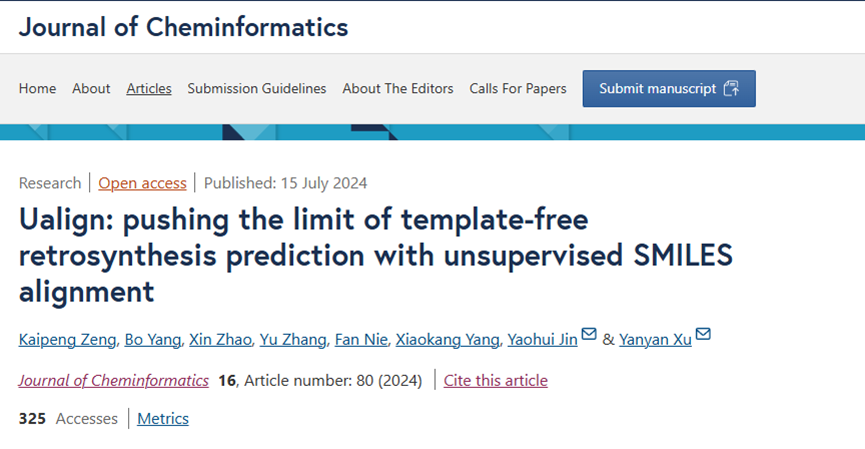
Model architecture of Graph to Sequence
If atoms are regarded as nodes, By treating chemical bonds as edges, the molecular structure can be naturally transformed into a graph structure. Compared with sequence models, graph neural networks can better capture the topological structure information inside molecules, thereby achieving more accurate molecular characterization. In addition, compared with other graph structures, chemical bonds in chemical molecules carry rich chemical property information. Based on these advantages, the author proposes a variant based on Graph Attention Network to replace the encoder part in the Transformer model, aiming to provide more powerful molecular representation capabilities for downstream applications.
Unsupervised SMILES alignment mechanism
In single-step retrosynthetic prediction, the use of sequence modeling methods usually means that the structure of the reactants must be constructed from scratch, and cannot Make direct modifications based on existing products to efficiently utilize identical substructures between reactants and products. This approach limits the accuracy of generated results to some extent. Considering that the molecular SMILES representation commonly used in sequence modeling actually arranges the atoms and chemical bonds in the molecule in the order of depth-first search, if the position information of each product atom appearing in the reactant SMILES representation can be provided to the model, it will Helps the model identify and reuse substructures that have not changed during the reaction. This will significantly reduce the difficulty for the model to predict reactants and improve the accuracy of predictions. From the perspective of sequence modeling, the commonly used molecular SMILES characterization essentially arranges the atoms and chemical bonds in the molecule according to the order of depth-first search (DFS). If the position information of each atom in the product in the SMILES representation of the reactants can be provided to the model, it will greatly facilitate the model's identification and reuse of unchanged substructures, thereby significantly reducing the difficulty of predicting reactants and improving predictions. accuracy. However, providing this correspondence information directly may introduce the risk of information leakage during model training. To avoid this problem, the researchers proposed an innovative strategy to optimize the model's ability to understand and predict the molecular structure of the reactants without leaking label information. Considering that SMILES sequence characterization is derived from depth-first search on molecular graphs, and most substructures between reactants and products are highly consistent, for a given DFS sequence of any product, there must be a corresponding one The DFS order on the molecular diagram of the reactants is such that the corresponding atoms on the reactants and products appear in almost the same order. Based on this strategy, the researchers not only incorporated the product molecular structure into the model input, but also introduced the DFS order of the reactant molecules as part of the input. In addition, according to the above strategy, the researchers generated a product molecule DFS sequence that is highly consistent with the DFS sequence of a given reactant, and used this sequence to generate a SMILES representation of the reactant as the target of model training. This design allows similar substructures between reactants and products to be arranged in almost the same order in the input and output of the model, thus simplifying the process of the model learning the same structural correspondence between reactants and products, and helping Identify the groups that change during the reaction.Even when the reactant structure is constructed from scratch, this method can effectively reuse product structure information and significantly improve the accuracy of prediction.
Particularly important is that since the DFS order of the product is only based on its molecular structure information and does not rely on any information about the reactants as annotations, this method effectively avoids the problem of label leakage during the model training process.
At the same time, this unsupervised SMILES alignment method does not require the introduction of additional supervision signals during the training process, thereby avoiding complex data annotation and optimization problems in multi-task learning, and provides a novel method for the field of molecular retrosynthesis prediction. and efficient research methods.
Experimental results display
In this study, the author conducted a systematic evaluation of multiple molecular retrosynthesis prediction data sets, covering the widely used USPTO-50K data set, as well as the USPTO-50K data set with a larger amount of data. MIT and USPTO-FULL.
When evaluating model performance, top-k accuracy is used as the main evaluation index. On the USPTO-50K data set, the author not only examined the legality of the SMILES sequence generated by the model, but also conducted a loopback verification of the practical feasibility of the synthesis scheme output by the model through a large-scale pre-trained forward reaction prediction model.
Table 1: Top-k accuracy of USPTO-50K retrosynthetic predictions

The experimental results of the USPTO-50K data set are summarized in Table 1, showing that the UAlign model performs better in USPTO when the specific reaction type is not specified The top-5 accuracy on the -50K data set is as high as 84.6%, significantly better than other template-free baseline models.
Table 2: Top-k accuracy of USPTO-MIT retrosynthetic prediction
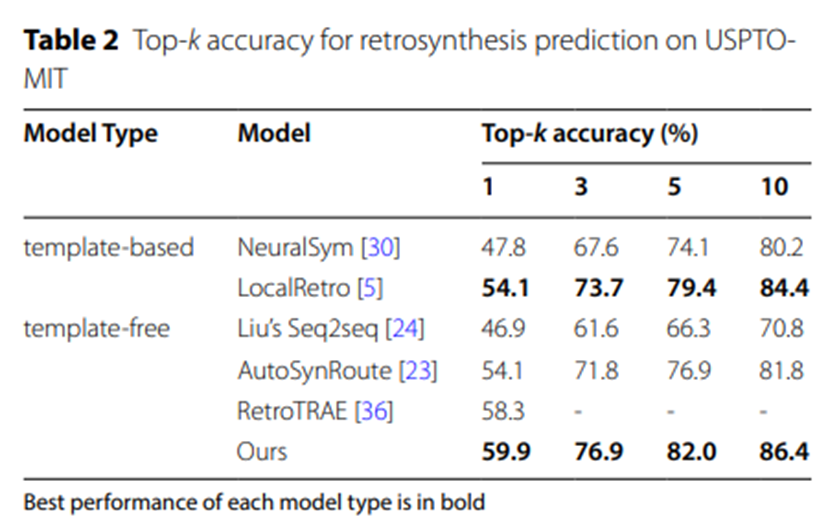
The experimental data in Table 2 and Table 3 further confirm that on the larger-scale data sets USPTO-MIT and USPTO-FULL, UAlign The model surpasses other various baseline models by significant advantages.
Table 3: Top-k accuracy of retrosynthetic prediction on USPTO-FULL
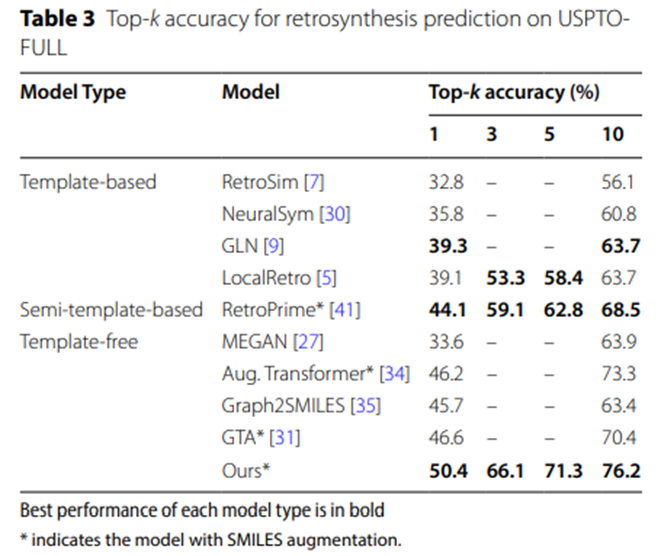
In addition, the experimental results in Table 4 show that compared with other SMILES-based retrosynthetic prediction models, the reactants generated by the UAlign model The SMILES sequence has higher legitimacy.
Table 4: Top-k SMILES effectiveness for retrosynthetic predictions of unknown reaction classes on USPTO-50K
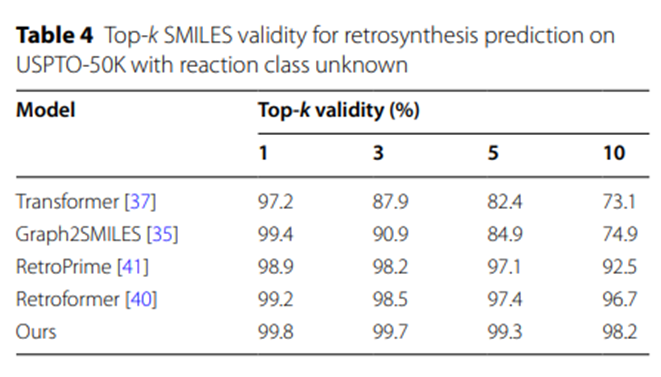
The experimental data in Table 5 further highlights the UAlign model’s ability to generate reasonable and feasible synthesis schemes. Advantage. The reason is that a relatively high proportion of the synthetic schemes proposed by UAlign can pass the verification of the forward reaction prediction model, that is, these schemes can be effectively converted into given target products after corresponding chemical reactions.
Table 5: Top-k round-trip accuracy for retrosynthesis prediction with unknown reaction categories on USPTO-50K
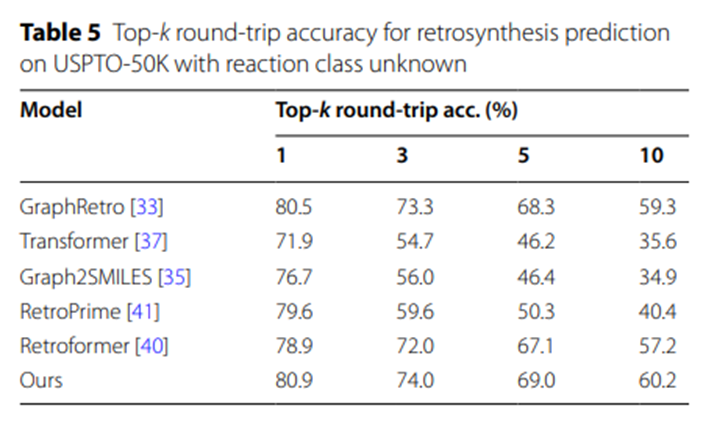
These experimental results not only verify the efficiency and accuracy of the UAlign model in the molecular retrosynthesis prediction task, but also It highlights its excellent performance when processing large-scale data sets and its significant advantages in generating high-quality synthesis solutions.
In order to verify the application potential of the UAlign model in actual production, the author selected new drugs approved by the U.S. Food and Drug Administration (FDA) in the past two years as synthesis targets. Through multiple iterations of the model, the synthesis was successfully obtained. route. The model's predictions of the synthetic routes for these two drugs are highly consistent with the pathways documented in the literature.
In addition, for the third drug, the synthetic route predicted by the model has also been recognized as feasible by experts in the field of chemistry. These synthetic pathways not only cover a variety of reaction types, but also include complex situations such as the synthesis of cyclic compounds and single-step retrosynthetic predictions involving multiple reaction centers.
The above experimental results fully prove that the UAlign model can not only cope with diverse reaction types, but also has high application value in actual production. This shows that the UAlign model has strong practicability and flexibility in the field of molecular retrosynthesis prediction and can provide effective solutions for drug synthesis.
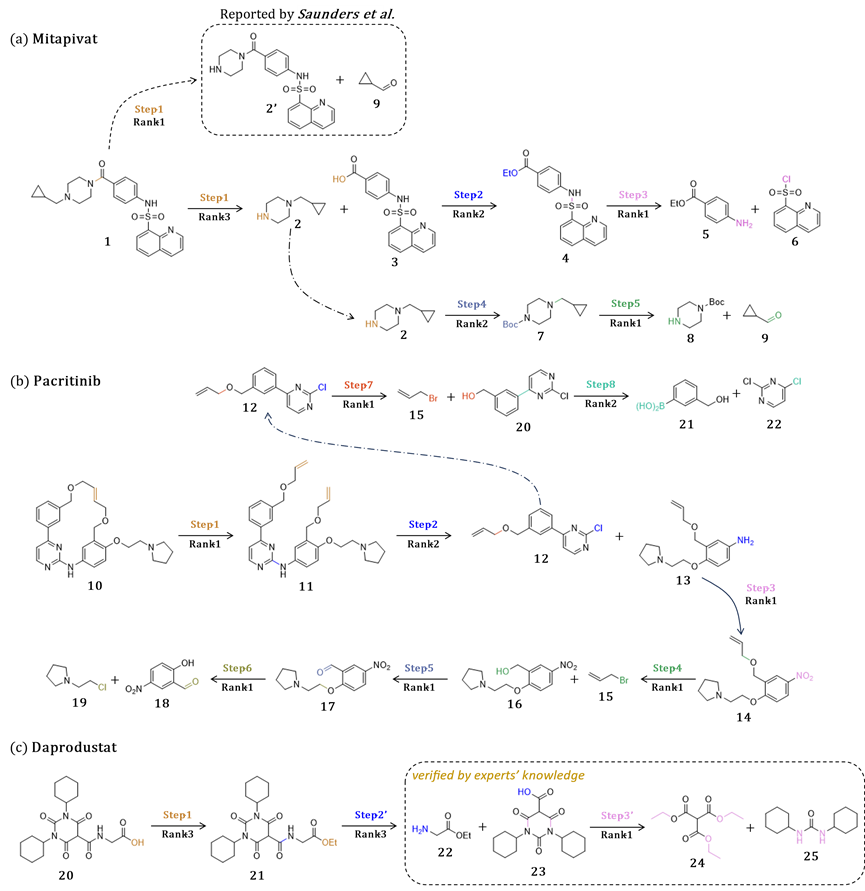
Future outlook
With its excellent performance and flexibility, the UAlign model is fully capable of serving as the cornerstone of building a multi-step retrosynthetic system. It can be combined with various search algorithms and multi-objective optimization technology to form an efficient and intelligent retrosynthetic path planning system.
In addition, the author is also actively exploring the integration of UAlign algorithm with advanced hardware equipment to create an automated unmanned laboratory to promote the automation of drug discovery and synthesis processes, bringing revolutionary changes to the fields of chemical research and drug development. change.
The above is the detailed content of Chemical retrosynthesis SOTA! Shanghai Jiao Tong University team proposes SMILES alignment technology to achieve efficient retrosynthetic prediction. For more information, please follow other related articles on the PHP Chinese website!

Hot AI Tools

Undresser.AI Undress
AI-powered app for creating realistic nude photos

AI Clothes Remover
Online AI tool for removing clothes from photos.

Undress AI Tool
Undress images for free

Clothoff.io
AI clothes remover

Video Face Swap
Swap faces in any video effortlessly with our completely free AI face swap tool!

Hot Article

Hot Tools

Notepad++7.3.1
Easy-to-use and free code editor

SublimeText3 Chinese version
Chinese version, very easy to use

Zend Studio 13.0.1
Powerful PHP integrated development environment

Dreamweaver CS6
Visual web development tools

SublimeText3 Mac version
God-level code editing software (SublimeText3)

Hot Topics
 1672
1672
 14
14
 1428
1428
 52
52
 1333
1333
 25
25
 1277
1277
 29
29
 1257
1257
 24
24
 DeepMind robot plays table tennis, and its forehand and backhand slip into the air, completely defeating human beginners
Aug 09, 2024 pm 04:01 PM
DeepMind robot plays table tennis, and its forehand and backhand slip into the air, completely defeating human beginners
Aug 09, 2024 pm 04:01 PM
But maybe he can’t defeat the old man in the park? The Paris Olympic Games are in full swing, and table tennis has attracted much attention. At the same time, robots have also made new breakthroughs in playing table tennis. Just now, DeepMind proposed the first learning robot agent that can reach the level of human amateur players in competitive table tennis. Paper address: https://arxiv.org/pdf/2408.03906 How good is the DeepMind robot at playing table tennis? Probably on par with human amateur players: both forehand and backhand: the opponent uses a variety of playing styles, and the robot can also withstand: receiving serves with different spins: However, the intensity of the game does not seem to be as intense as the old man in the park. For robots, table tennis
 The first mechanical claw! Yuanluobao appeared at the 2024 World Robot Conference and released the first chess robot that can enter the home
Aug 21, 2024 pm 07:33 PM
The first mechanical claw! Yuanluobao appeared at the 2024 World Robot Conference and released the first chess robot that can enter the home
Aug 21, 2024 pm 07:33 PM
On August 21, the 2024 World Robot Conference was grandly held in Beijing. SenseTime's home robot brand "Yuanluobot SenseRobot" has unveiled its entire family of products, and recently released the Yuanluobot AI chess-playing robot - Chess Professional Edition (hereinafter referred to as "Yuanluobot SenseRobot"), becoming the world's first A chess robot for the home. As the third chess-playing robot product of Yuanluobo, the new Guoxiang robot has undergone a large number of special technical upgrades and innovations in AI and engineering machinery. For the first time, it has realized the ability to pick up three-dimensional chess pieces through mechanical claws on a home robot, and perform human-machine Functions such as chess playing, everyone playing chess, notation review, etc.
 Claude has become lazy too! Netizen: Learn to give yourself a holiday
Sep 02, 2024 pm 01:56 PM
Claude has become lazy too! Netizen: Learn to give yourself a holiday
Sep 02, 2024 pm 01:56 PM
The start of school is about to begin, and it’s not just the students who are about to start the new semester who should take care of themselves, but also the large AI models. Some time ago, Reddit was filled with netizens complaining that Claude was getting lazy. "Its level has dropped a lot, it often pauses, and even the output becomes very short. In the first week of release, it could translate a full 4-page document at once, but now it can't even output half a page!" https:// www.reddit.com/r/ClaudeAI/comments/1by8rw8/something_just_feels_wrong_with_claude_in_the/ in a post titled "Totally disappointed with Claude", full of
 At the World Robot Conference, this domestic robot carrying 'the hope of future elderly care' was surrounded
Aug 22, 2024 pm 10:35 PM
At the World Robot Conference, this domestic robot carrying 'the hope of future elderly care' was surrounded
Aug 22, 2024 pm 10:35 PM
At the World Robot Conference being held in Beijing, the display of humanoid robots has become the absolute focus of the scene. At the Stardust Intelligent booth, the AI robot assistant S1 performed three major performances of dulcimer, martial arts, and calligraphy in one exhibition area, capable of both literary and martial arts. , attracted a large number of professional audiences and media. The elegant playing on the elastic strings allows the S1 to demonstrate fine operation and absolute control with speed, strength and precision. CCTV News conducted a special report on the imitation learning and intelligent control behind "Calligraphy". Company founder Lai Jie explained that behind the silky movements, the hardware side pursues the best force control and the most human-like body indicators (speed, load) etc.), but on the AI side, the real movement data of people is collected, allowing the robot to become stronger when it encounters a strong situation and learn to evolve quickly. And agile
 ACL 2024 Awards Announced: One of the Best Papers on Oracle Deciphering by HuaTech, GloVe Time Test Award
Aug 15, 2024 pm 04:37 PM
ACL 2024 Awards Announced: One of the Best Papers on Oracle Deciphering by HuaTech, GloVe Time Test Award
Aug 15, 2024 pm 04:37 PM
At this ACL conference, contributors have gained a lot. The six-day ACL2024 is being held in Bangkok, Thailand. ACL is the top international conference in the field of computational linguistics and natural language processing. It is organized by the International Association for Computational Linguistics and is held annually. ACL has always ranked first in academic influence in the field of NLP, and it is also a CCF-A recommended conference. This year's ACL conference is the 62nd and has received more than 400 cutting-edge works in the field of NLP. Yesterday afternoon, the conference announced the best paper and other awards. This time, there are 7 Best Paper Awards (two unpublished), 1 Best Theme Paper Award, and 35 Outstanding Paper Awards. The conference also awarded 3 Resource Paper Awards (ResourceAward) and Social Impact Award (
 Li Feifei's team proposed ReKep to give robots spatial intelligence and integrate GPT-4o
Sep 03, 2024 pm 05:18 PM
Li Feifei's team proposed ReKep to give robots spatial intelligence and integrate GPT-4o
Sep 03, 2024 pm 05:18 PM
Deep integration of vision and robot learning. When two robot hands work together smoothly to fold clothes, pour tea, and pack shoes, coupled with the 1X humanoid robot NEO that has been making headlines recently, you may have a feeling: we seem to be entering the age of robots. In fact, these silky movements are the product of advanced robotic technology + exquisite frame design + multi-modal large models. We know that useful robots often require complex and exquisite interactions with the environment, and the environment can be represented as constraints in the spatial and temporal domains. For example, if you want a robot to pour tea, the robot first needs to grasp the handle of the teapot and keep it upright without spilling the tea, then move it smoothly until the mouth of the pot is aligned with the mouth of the cup, and then tilt the teapot at a certain angle. . this
 Distributed Artificial Intelligence Conference DAI 2024 Call for Papers: Agent Day, Richard Sutton, the father of reinforcement learning, will attend! Yan Shuicheng, Sergey Levine and DeepMind scientists will give keynote speeches
Aug 22, 2024 pm 08:02 PM
Distributed Artificial Intelligence Conference DAI 2024 Call for Papers: Agent Day, Richard Sutton, the father of reinforcement learning, will attend! Yan Shuicheng, Sergey Levine and DeepMind scientists will give keynote speeches
Aug 22, 2024 pm 08:02 PM
Conference Introduction With the rapid development of science and technology, artificial intelligence has become an important force in promoting social progress. In this era, we are fortunate to witness and participate in the innovation and application of Distributed Artificial Intelligence (DAI). Distributed artificial intelligence is an important branch of the field of artificial intelligence, which has attracted more and more attention in recent years. Agents based on large language models (LLM) have suddenly emerged. By combining the powerful language understanding and generation capabilities of large models, they have shown great potential in natural language interaction, knowledge reasoning, task planning, etc. AIAgent is taking over the big language model and has become a hot topic in the current AI circle. Au
 Hongmeng Smart Travel S9 and full-scenario new product launch conference, a number of blockbuster new products were released together
Aug 08, 2024 am 07:02 AM
Hongmeng Smart Travel S9 and full-scenario new product launch conference, a number of blockbuster new products were released together
Aug 08, 2024 am 07:02 AM
This afternoon, Hongmeng Zhixing officially welcomed new brands and new cars. On August 6, Huawei held the Hongmeng Smart Xingxing S9 and Huawei full-scenario new product launch conference, bringing the panoramic smart flagship sedan Xiangjie S9, the new M7Pro and Huawei novaFlip, MatePad Pro 12.2 inches, the new MatePad Air, Huawei Bisheng With many new all-scenario smart products including the laser printer X1 series, FreeBuds6i, WATCHFIT3 and smart screen S5Pro, from smart travel, smart office to smart wear, Huawei continues to build a full-scenario smart ecosystem to bring consumers a smart experience of the Internet of Everything. Hongmeng Zhixing: In-depth empowerment to promote the upgrading of the smart car industry Huawei joins hands with Chinese automotive industry partners to provide



